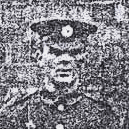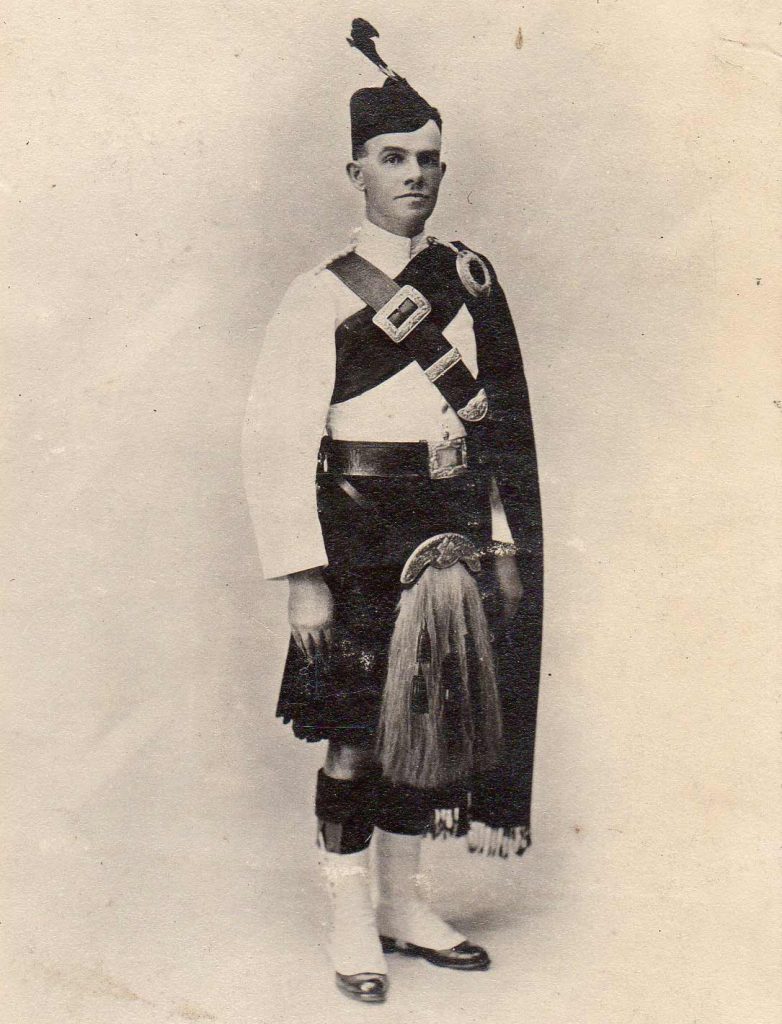Great War Dundee
This is Dundee's story of those that served in the First World War, and of the people left at home
David Paterson
Military Information
- Date of enlistment:
- Place of enlistment: Dundee
- Service no: Pre 1917: (T)489. Post 1917: 410290
- Rank: Acting Sergeant
- Service Occupation:
- Awards:
- Regiment/Service: Royal Engineers
- Unit/Ship: 1st Dundee Fortress Works Company, renamed in 1917 to, 554 (Dundee) Army Troops Company.
Personal Information
- Date of Birth: 27 June 1890
- Place of Birth: Dundee
- Address: 15 South Mid Street, Lochee, Dundee*
- Occupation: Electrical Engineer
- Mother:
Anne Runciman (19.06.1859 – 17.10.1932)
- Father:
William Paterson (03.04.1860 – 14.10.1927)
- Siblings:
Jane Ann, Henry ‘Harry’, Robert** ‘Bert’ (also survived WW1), Mary, Madelaine. (1911 census recorded 10 born 6 still living)
- Spouse:
Elizabeth Moonie Whitton – Known as Daisy. (09.02.1892 – 28.9.1963)
- Children:
David Whitton Hutton Paterson*** b.1915, Anne Paterson b 1916, Robert Paterson b 1918, Mary Paterson b.1920. (All deceased)
- Age at Death: 53
- Date of Death: 10 Sep 1943
- Place of Death: Calcutta, India
- Burial Country: India
- Cemetery: Tollygunge
More about David Paterson
David Paterson grew up in Dundee at a time of great change. The jute industry had reached its height and by the turn of the 20th century was beginning it’s decline and yet it was the jute industry that would shape much of his adult life as a skilled electrical engineer. One of 6 children, like many other working class families of the time life would have been hectic in the crowded Paterson family.
David was highly regarded for his hardworking and conscientious nature. He was disciplined and driven, making him ambitious both in his career and personal life. Even at a young age David had his sights set on making the most of his life.
Pre World War One
David would have left school around 1904, aged 14. At some point after that date he took up an apprenticeship in a local company D.J. Macdonald, an engineering company and maker of textile manufacturing machinery and mill furnishers, one of a few such companies in Dundee.
There would have been a number of opportunities for an ambitious hard working lad at D. J. Macdonald and David pursued Electrical Engineering. In 1909 he started evening classes at the local college which he continued for the following five years. During his time at college David was consistently graded first class in every subject. At the end of his first course he was considered the best student of the year and was awarded the Armistead Medal: the highest medal the College could bestow.
In September 1911 David was 21 years old and possibly looking for a new challenge. A letter from Captain Reid of the 6th Dundee Boys Brigade from around the time speaks highly of David. “…Smart, energetic, intelligent and painstaking, he is enthusiastic and faithful in a remarkable degree. …I am convinced that only the lack of opportunity will prevent him from obtaining to a position of eminence in his profession.” This letter was possibly a reference for David to take up employment at the Electricity Supply Department.
Similarly a letter by his employer, David Macdonald, supporting David’s application to University College Bursaries speaks volumes of the respect he held for David. “…One rarely comes across a case of ability in Practical Work, so combined with the highest successes in Theoretical Work, as has been evidenced in David Paterson’s career.”
In December 1911 David Joined the Dundee Electricity Supply Department as a junior engineer. Dundee had it’s own coal fired power generation station named Carolina Port (later Carolina A) located at the old Stannergate on The River Tay. The growing demand for electricity in the city would have represented an enormous opportunity for David and no doubt he saw a long a secure career ahead of him. Carolina A remained in operation until 1977. It’s sister oil fired station Carolina B which opened in 1965, closed just a few years later in 1982. The original power station was converted to oil in the early 70s and consequently both were victims of the volatile oil prices of the 70s.
The war years
Throughout David’s life he displayed an absolute devotion to the military and yet it is with a possible fortuitous irony for David’s descendants that the combination of his interest in serving his country in peacetime together with his technical qualifications meant he more than likely remained in Britain throughout the war. Many occupations were considered vital during the war resulting in men being excused from conscription. As the war continued power generation would have been a vital service to factories supporting the war effort but we know though from a reference letter dated after the war that David spent the entire war in the army.
 Prior to the war it is possible David, along with his brother Bert, was already a volunteer soldier in the Dundee Fortress Royal Engineers; a volunteer Territorial Force formed in 1908. We believe this is David pictured right in 1916 in The Electric Lights Company City of Dundee Fortress Royal Engineers. It is likely others in his workplace were also Territorial Force volunteers. As David was already a volunteer before the war he probably remained stationed in Scotland on Firth of Tay defences and was possibly close enough to continue living at home. New recruits at the beginning of the war were posted to defend the Essex coast. (More information about Dundee Fortress Royal Engineers). Such was the perceived threat of attack that around half a million men were retained in Britain for Home Defence.
Prior to the war it is possible David, along with his brother Bert, was already a volunteer soldier in the Dundee Fortress Royal Engineers; a volunteer Territorial Force formed in 1908. We believe this is David pictured right in 1916 in The Electric Lights Company City of Dundee Fortress Royal Engineers. It is likely others in his workplace were also Territorial Force volunteers. As David was already a volunteer before the war he probably remained stationed in Scotland on Firth of Tay defences and was possibly close enough to continue living at home. New recruits at the beginning of the war were posted to defend the Essex coast. (More information about Dundee Fortress Royal Engineers). Such was the perceived threat of attack that around half a million men were retained in Britain for Home Defence.
Post WW1
On 13th February 1919 David returned to work at the Dundee Electricity Supply Department. In May 1919 he was promoted to a Senior Shift Engineer.
By this time in Dundee the jute industry was in decline and was being superceded by the Indian end of the industry where the jute was grown. The first evidence of this switch can be traced back to 1855 when Dundee workers opened a mill at Serampore. Dundee facilitated the demise of its main industry by educating and sending engineers to assist in the running of the expanding Indian jute mills. Cutting out the shipping costs of the raw materials together with cheaper labour costs in India meant that Dundee mills found it increasingly harder to compete with India. By the beginning of WW1 Calcutta had 38 mills employing 184,000 workers, including 1,000 Scots.
In early 1920, David now aged 30, was planning his own career move to India where he would join his younger brother Bert. He was recruited by the Samnuggar Group, to work at their Gondalpara Jute Mill, Calcutta, as an electrical and mechanical engineer. No doubt his new employer would have been impressed with his references especially the one from the Head of Electrical Engineering at the Technical College. “…I have formed a high opinion of David Paterson’s ability and application to his work and can thoroughly recommend him to anyone requiring his services in whatever capacity his ability may lead him.”
Although David joined his brother Bert in Calcutta he did have to leave his own family behind in Dundee. This meant leaving his wife and 4 children; the youngest, Mary, not yet a year old. It would have been at least 18-24 months before David’s family would be allowed to join him. In the event it seems just David’s wife, Daisy, joined him, leaving all four of the children in Dundee to be cared for by aunts. It’s not known how long exactly Daisy stayed in India.
India proved to be quite a magnet for David’s wider family. At one time in India in the 1930s, there were the three brothers Harry, David and Bert; Harry’s sons, David’s sons David*** and another Bert; and sister Mary’s son. As David’s granddaughter, Carol Turnham who moved out to India in 1954 aged 6, quotes, “No wonder I came home from being in India as a child, with a Scottish accent!” And certainly as supported by Dr Bashabi Fraser’s fascinating paper ‘The Scottish Jutewallah (PDF)’ suggests, large numbers of Scots did indeed live in communities separate from local people.
David’s love for the army continued in India where he joined the Calcutta Scottish Volunteers. He is pictured above in his uniform.
On the 10th September 1943 David died, aged just 53. He is buried at Tollygunge, Calcutta.
Working in an Indian jute mill
Below is a short recording of a Dundee man, Tom Shepherd, who after World War 2 left Dundee for India. Although separated by some 25 years Tom’s story provides an insight to life working in an Indian jute company.
*Additional recorded addresses: 178 High Street Lochee. 37 High Street Lochee.
**David’s brother Bert also survived the war. In 1926 Bert’s son Ian was born. Bert and his wife returned from India for their children to attend School in Scotland. Ian Paterson enjoyed a career as singer and actor with roles on stage and television described here in The Scotsman 2008 obituary.
Special thanks to:
Carol Turnham, granddaughter to David Paterson, for kindly submitting the above information. ***Carol’s father was, David Whitton Hutton Paterson.
Additional thanks to:
Mick Harness and Dave Lane from the Royal Engineers Association for their assistance investigating David’s service record. The Tom Shepherd sound clip is reproduced with the permission of Dundee Oral History Project, University of Dundee Archive Services.
Can you tell us more about David Paterson'? Some additional facts, a small story handed down through the family or perhaps a picture or an heirloom you can share online. Contact our curator...

